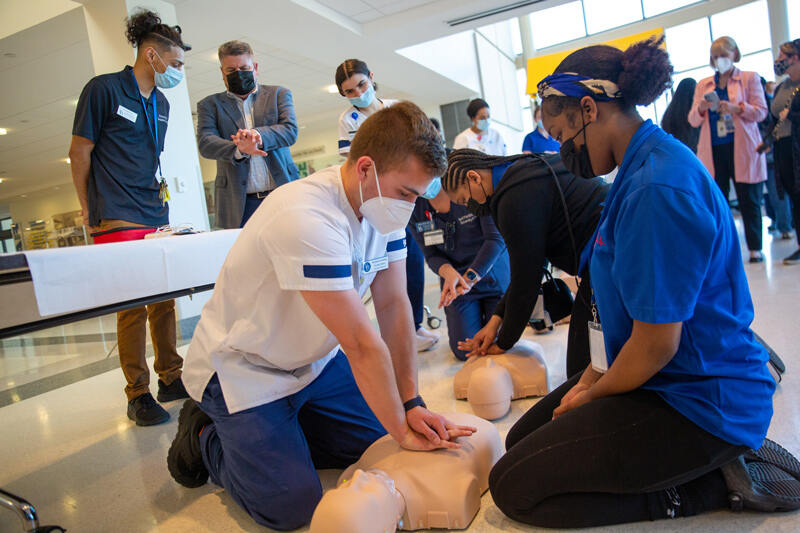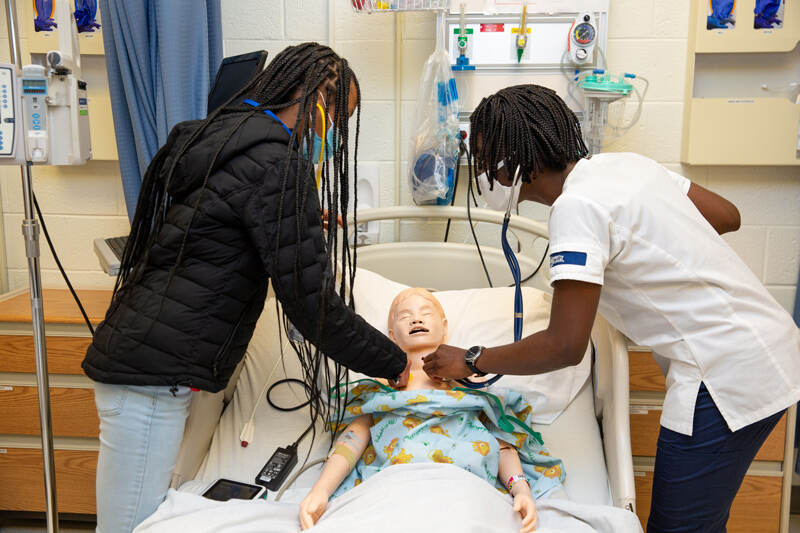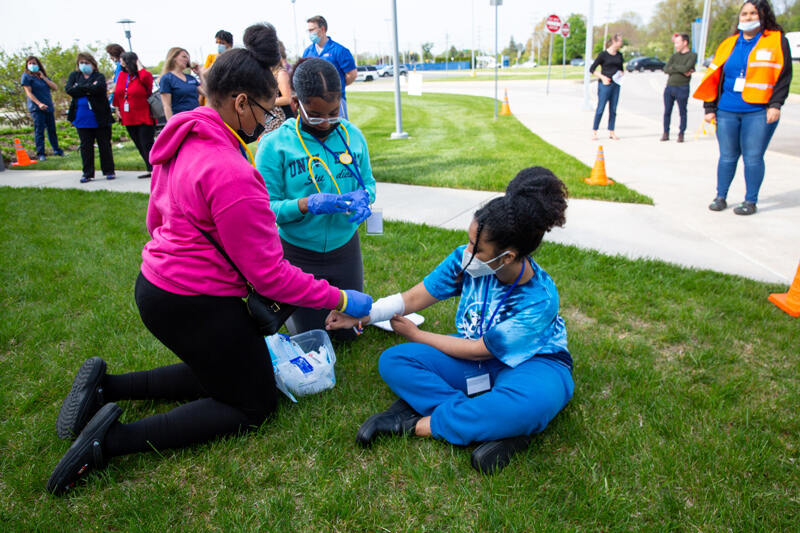Middle school students learning about nursing at UD: youtube.com/watch?v=1yB6cWZg_MM
UD’s School of Nursing and Brandywine School District partner to spark early interest in nursing careers
A simulated hospital room was strewn with needles, bloody tissues, tangled wires, and other unsafe and unsanitary conditions. Middle schoolers from the Brandywine School District (BSD) looked around wide-eyed and were asked to tell University of Delaware School of Nursing staff what they thought was wrong.
“He’s got pills in his hand,” one student said.
Another yelled: “He’s dead! His breathing mask isn’t even on his face.”
“There’s syringes on the bed, and the baby is about to fall on the floor,” remarked a third student.
“Is that a cord around the baby’s neck?” a student asked.
Students would then put on their critical thinking caps and suggest ways to make the hospital room safer.
“Instead of just giving them answers, we really want them to think through and figure it out themselves and see not just what’s wrong, but how can I fix it,” Sumyya Tahch, a senior nursing major.
The students would return to campus twice more in May to learn vital signs, resuscitation skills and how to save lives in the event of a disaster. In the maternity room, one student asked: “Why do babies come out blue?”
“I tried to get them to figure out themselves why a person would be blue — they’re not breathing,” Tahch said.
The students’ after school visits to campus were made possible through the creation of the Brandywine Lifesavers program, a partnership between the School of Nursing in the College of Health Sciences and BSD that aims to pique kids’ interest in nursing careers at an early age.

The Delaware Nurses Action Coalition and BSD were awarded the Nursing Innovations Fund Award, supported by the Robert Wood Johnson Foundation and AARP along with funds from the district and UD SON.
“We want nurses that are representative of all communities,” said Beth Mattey, coordinator of school health for BSD. “This program focuses on informing middle schoolers, especially students from racially and ethnically diverse backgrounds and young men about potential career opportunities in nursing.”
The BSD Lifesavers program supports the goals of the National Academy of Medicine’s Future of Nursing 2020-2030 Report to reduce healthcare disparities and improve the health of all through nursing. BSD was the first school district in the state, and one of just six nationally, to receive the award which emphasizes health equity.
“The girls really didn’t think they could be nurses,” said Richele Lawson, the school nurse at P.S. duPont Middle School. “So, we wanted to expose them to nursing and show them possible pathways, to bring underserved students of diverse backgrounds or males into nursing with the hope that they’ll go back to their community and provide services.”
That’s also one of the College of Health Sciences’ and the School of Nursing’s main priorities: diversifying the healthcare workforce pipeline to ensure that the workforce looks like the people it serves.
“We want these students to envision themselves becoming a nurse,” said Elizabeth Speakman, senior associate dean of the School of Nursing. “If you start to have these conversations with middle schoolers, they start to look at nursing as a potential career and then make decisions on coursework or volunteer efforts based on that.”
For UD’s School of Nursing, the collaboration, which involves the Student Nurses Organization, Men in Nursing, and the Highmark Diversity Scholars, aims to plant the seed that a career in nursing is a possibility for these students. Planting that seed at a young age is particularly important among boys, Speakman said.
“I’ve had middle school students say to male students: ‘You can be a nurse and be a man? I didn’t know that,’” Speakman said.
For students who decide halfway through high school that they want to pursue a career in nursing, it can sometimes be too late. Often, a rigorous course load and Advanced Placement classes are recommended to prepare students for college-level nursing courses.
“You must pick certain courses that have an affinity for the sciences,” Speakman said. “In high school, if you can double up on your sciences, it gives a stronger presentation for admission into schools of nursing.”

A secondary goal of the partnership is to increase Delawareans’ footprints in UD’s School of Nursing by advancing enrollment opportunities for in-state students in hopes that after graduation they remain in their home state to provide healthcare services.
Michelle Scott, a nurse at Brandywine High School, who helped create the Lifesavers program at Springer Middle, said they were targeting first-generation college students with an interest in nursing.
“They had to get a personal reference from a teacher, from a parent, and then write an essay themselves about why they want to join the Lifesavers program,” said Scott.
A total of 30 students from P.S. duPont, Springer, and Talley middle schools joined the Lifesavers program which began March 2 and included a weekly in-school component where students learned about basic first aid and professionalism.
“The simulation labs at UD have just been amazing,” said Scott. “The students have been so excited about it. A lot of them interacted with nursing students to find out what made them want to be a nurse and the struggles some of them have had. It’s a great opportunity for them to see what nursing is like.”
Raegan Clark, a seventh grader at Springer Middle, said she wanted to be a nurse since she practiced caring for her baby dolls at a younger age. She said she hopes to become a pediatric nurse.
“I knew there were only 10 available spots,” Clark said, “and I was really hoping I’d get into this program because I knew it would affect my future life and what I want to do when I’m older. I just think it’s so cool helping people and making people’s day.”
On the students’ final visit to UD’s Science, Technology and Advanced Research (STAR Campus) on May 10, students played the roles of victims and caregivers following a mock chemical explosion that left some victims with fake glass protruding from their arms. The full range of SON’s impressive technology was on display from life-like mannequins and healthcare theatre to moulage— special effects make-up that mimics gruesome wounds and burns.
Springer Middle School student Lucy O’Brien played a victim and may have a future in healthcare theatre.
“It was really crazy,” she said. “I had a broken arm, and I made up my own backstory that I’d been trampled by a bunch of kids, and I fell on it weird, and it broke.”
She said fellow middle schoolers who served as caretakers performed well.
“They put a sling on me and gave me ice,” O’Brien said.
O’Brien hopes to be a nurse in a maternity ward. When she heard about the Lifesavers program, she was among the first people to apply for the program.
“I learned that you should always be prepared for everything, and if something bad happens, stay calm and call 911,” O’Brien said.

P.S. duPont seventh grade student Ibrahem Elsayed learned similar lessons. He served as an incident commander during the disaster drill.
“I learned that being nervous accomplishes nothing — you’ve got to overcome your fear,” said Elsayed.
Elsayed said he is considering becoming a nurse, but admitted, he’s got a lot to learn beyond taking a pulse and blood pressure readings.
“I want to learn CPR and more stuff to save lives because I want to be a hero because doctors and nurses are heroes,” Elsayed said.
Simulation lab instructor and specialist April Prior called this the beginning of an important partnership.
“I hope this is making it real for them and that it inspires them to think about their long-term goals and just get a taste of nursing. I hope they walk away thinking this is a really cool career path,” said Prior.
Yorlet Torres, a first-year nursing student at UD, wishes she had a program like this in middle or high school.
“I would have been so much more prepared for nursing school,” Torres said. “I thought the acting was interesting, and it was interesting how some students knew what to do without instruction. They knew they had to clean wounds, wrap them, and make sure to apply pressure and take vitals.”
Speakman said the School of Nursing is planning to expand the Lifesavers program to additional middle schools and high school students next year which was welcome news to Tahch.
“This is an incredible experience and great opportunity for these kids,” Tahch said. “Not everyone is meant for nursing, but I hope that this influences them or makes a difference in how they view this career and shows them the difference they can make.”
Scott said she hopes this program shows students that the possibilities for their future are endless.
“With the seed programs and scholarships, there’s just so many opportunities for students,” Scott said. “I told them: ‘I was poor, I had no dad and a single mom working jobs, and I was able to do it.’ If you want to do it, you find a way to do it. I tell them nothing is out of reach.”
She expects that one day, this program will come full circle, and some of these students will enroll in UD’s School of Nursing and be teaching the next generation of nurses.
“It gives me goosebumps just thinking about it,” Scott said.

